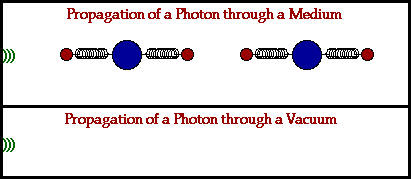
Propagation of an
Electromagnetic Wave
A GIF Animation
Electromagnetic waves are waves which can travel through the
vacuum of outer space. Mechanical waves, unlike electromagnetic
waves, require the presence of a material medium in order to
transport their energy from one location to another. Sound waves are
examples of mechanical waves while light waves are examples of
electromagnetic waves.
Electromagnetic waves are created by the vibration of an electric
charge. This vibration creates a wave which has both an electric and
a magnetic component. An electromagnetic wave transports its energy
through a vacuum at a speed of 3.00 x 108 m/s (commonly
known as "c"). The propagation of an electromagnetic wave through a
material medium occurs at a net speed which is less than 3.00 x
108 m/s. This is depicted in the animation below.
The mechanism of energy transport through a medium involves the
absorbtion and re-emission of the wave energy by the atoms of the
material. When an electromagnetic wave impinges upon the atoms of a
material, the energy of that wave is absorbed. The absorbtion of
energy causes the electrons within the atoms to undergo vibrations.
After a short period of vibrational motion, the vibrating electrons
create a new electromagnetic wave with the same frequency as the
first electromagnetic wave. While these vibrations occur for only a
very short time, they delay the motion of the wave through the
medium. Once the energy of the electromagnetic wave is re-emitted by
an atom, it travels through a small region of space between atoms.
Once it reaches the next atom, the electromagnetic wave is absorbed,
transformed into electron vibrations and then re-emitted as an
electromagnetic wave. While the electromagnetic wave will travel at
a speed of c (3 x 108 m/s) through the vacuum of
interatomic space, the absorbtion and re-emission process causes the
net speed of the electromagnetic wave to be less than c. This is
observed in the animation below.

The actual speed of an electromagnetic wave through a material
medium is dependent upon the optical density of that medium.
Different materials cause a different amount of delay due to the
absorbtion and re-emission process. Furthermore, different materials
have their atoms more closely packed and thus the amount of distance
between atoms is less. These two factors are dependent upon the
nature of the material through which the electromagnetic wave is
traveling. As a result, the speed of an electromagnetic wave is
dependent upon the material through which it is traveling.
For more information on physical descriptions of waves,
visit
The
Physics Classroom. Specific information is available there on the
following topics:
Other animations can be seen at the
Multimedia
Physics Studios. Other useful resources regarding the physics of
motion and waves is available through the
Glenbrook
South Physics Home Page.
This page was created by
Tom
Henderson of
Glenbrook South
High School.
Comments and suggestions can be sent by e-mail to
Tom
Henderson.
This page last updated on 8/17/98.
